One of the most acclaimed buildings of the 20th century, Berlin’s Neue Nationalgalerie (NNG), completed in 1968 by Ludwig Mies van der Rohe, reopened in late August after a six-year renovation by the British architect David Chipperfield. The black steel roof, glass hall, and granite base once again display their stark, unmitigated materiality, while the structure and mechanical systems have been substantially refurbished. “Seeing behind its exterior has revealed both its genius and its flaws, but overall it has only deepened my admiration for Mies’s vision,” says Chipperfield.
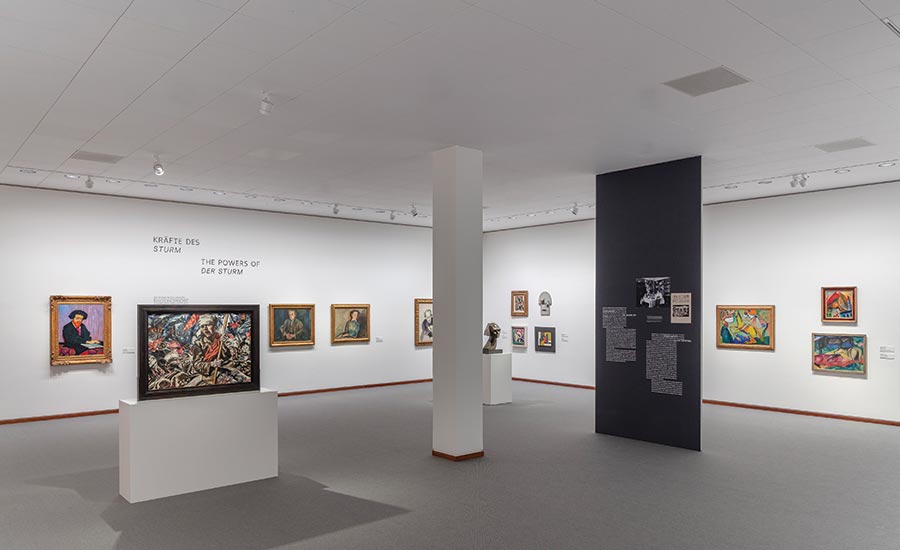
The lower level, in the plinth, contains the art galleries. Photo © David Von Becker, click to enlarge.
Whereas the Neue Nationalgalerie embodies the Miesian ideal— the articulation of form, structure, and detail in the service of a distinct architectural concept—it also displays its failings, such as the design of the main hall, a well-proportioned, glazed exhibition space void of sun protection. The glass facades cracked and were disfigured by condensation, a vivid demonstration of how aesthetic choices trumped quotidian demands.
Because so many of Berlin’s cultural institutions are located in the eastern part of the city, they came under Soviet control at the war’s end in 1945. To compensate, West Berlin, overseen by the Americans, French, and British, established the Kulturforum, an arts district south of the Berlin Wall. The Neue Nationalgalerie, displaying 20th-century art, along with the Philharmonie (1963) and State Library (1967–78), both by Hans Scharoun, were erected there. Since the late 1980s, other notable architecture has arisen around this site, including the Wissenschaftszentrum Berlin by James Stirling (1987) and the Potsdamerplatz development, with contributions by Arata Isozaki, Helmut Jahn, Raphael Moneo, Renzo Piano, Richard Rogers, and others. Now in construction, the Museum of the 20th Century, by Herzog & de Meuron, will open in 2026 directly north of the NNG.
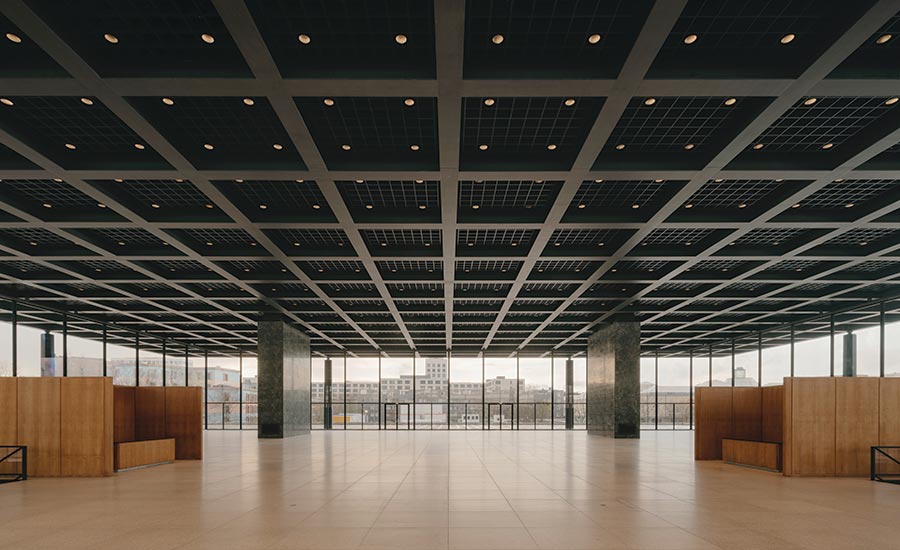
1
Elegant materials are refurbished in the street-level lobby (1); the stair (2) takes viewers down to the galleries (3). Photos © Simon Menges (1 & 2), David Von Becker (3)
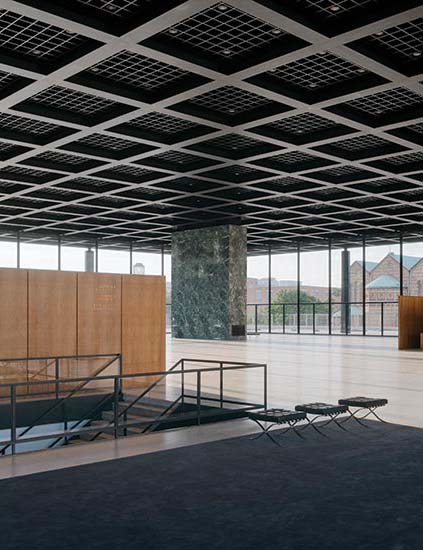
2
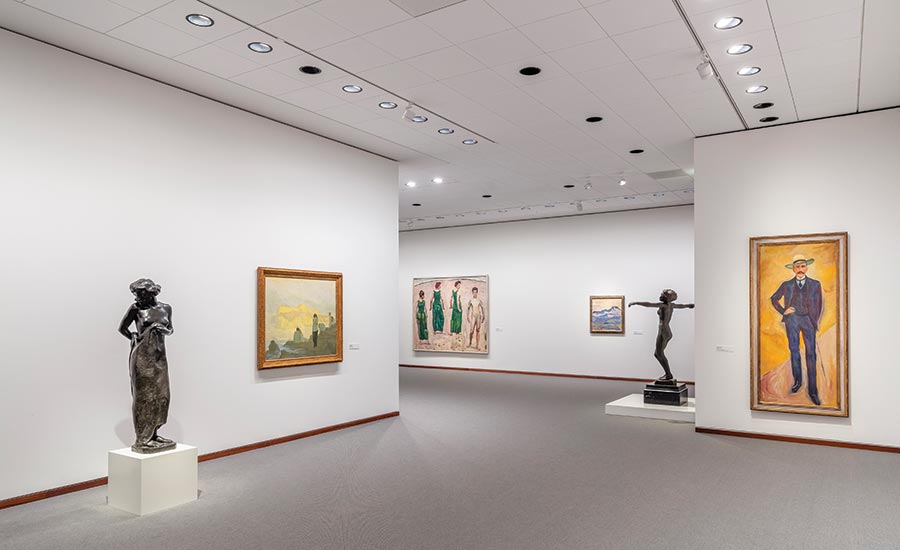
3
Initially critical of NNG’s bare-bones appearance, West Berliners eventually warmed to its diverse cultural offerings, from jazz in the garden to blockbuster exhibitions. After 1989, when the wall came down and Berlin turned into a magnet for international tourists, an estimated 300,000 people per year visited Mies’s museum. Yet by the time of its designation as a historic monument in 1995, the building was showing serious signs of aging. In 2011, an open, two-stage European-wide process was undertaken to select an architect for a thorough renovation. An international jury chose Chipperfield over 24 competitors, citing the firm’s desire to remain “invisible” while restoring Mies’s architecture. The firm’s earlier success with the restoration of the 19th-century Neues Museum, on Berlin’s Museum Island, helped, as did its ability to involve the stakeholders—clients, users, municipal authorities, consultants, and technical experts—in the decision-making.
Adopting the strategy “as much Mies as possible,” the client and the architects followed local preservation practices to protect the aura of the original building. Accordingly, all visible surfaces—the emerald-green Tinos marble, pale gray Silesian granite, honey-toned English oak, and matte black-painted steel—were retained and repaired, their patina intact. Damaged pieces were only replaced when necessary. For the refurbishing, restorers relied on original techniques, such as hand-painting metal surfaces. For the less durable finishes, new versions were fabricated for the bouclé woven salt-and-pepper wool carpeting on the lower-level galleries and the diaphanous dove-gray wool curtains lining the glass hall, as well as for the deep-brown leather cushions of Barcelona chairs and stools.
Concealed components, such as the building systems, were completely overhauled, and hazardous materials eliminated. When the firm removed the granite cladding to insert new waterproofing and insulation, it found the underlying reinforced concrete to be of poor quality, a circumstance of West Berlin’s limited resources in the 1960s. That led to the team’s extensively renewing the structure.
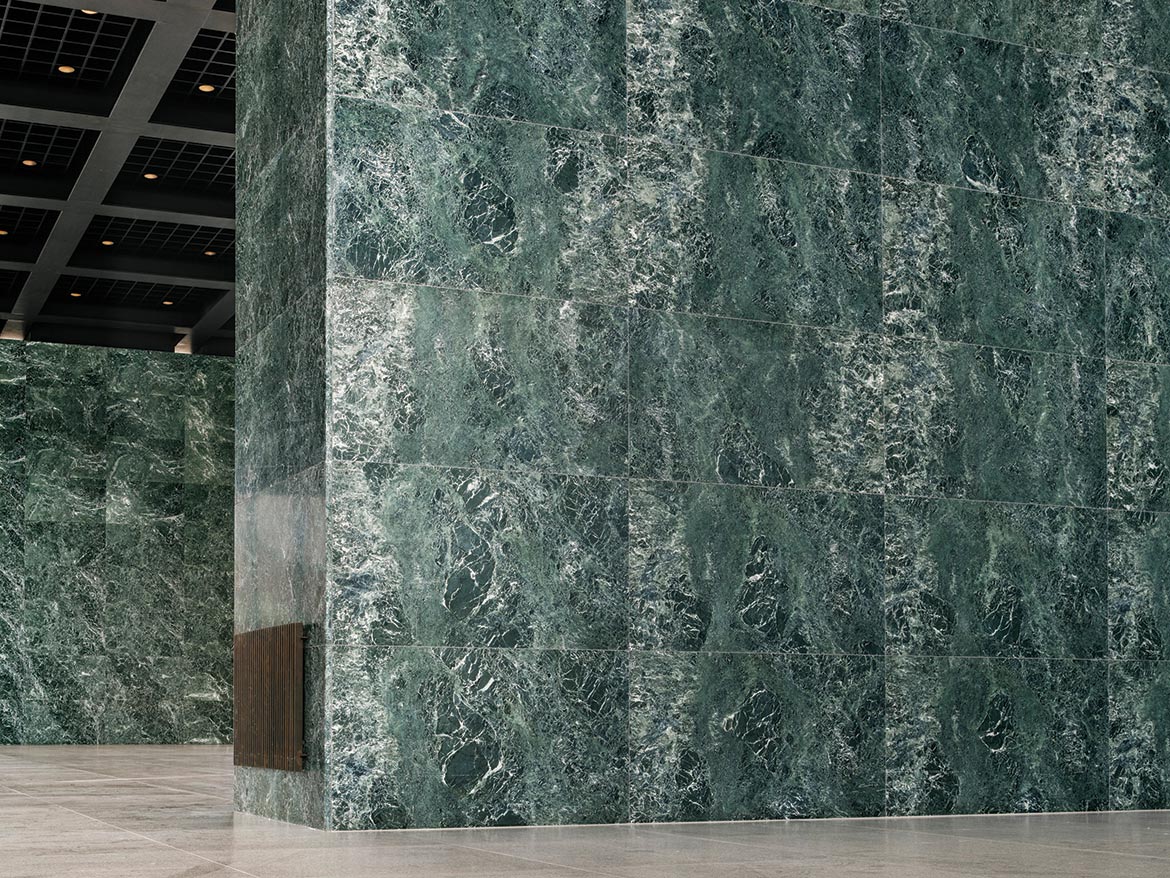
Photo © Simon Menges
For Chipperfield, the building’s three parts—the glass hall, the plinth, the garden—fulfill the complex demands of a museum. But it is the glass hall, or temple, planned as a monumental gesture in affirmation of new public institutions in the aftermath of war, that has special meaning. It is “an incredibly optimistic utopian stage,” he says, where civic life can unfold. Yet because its relentless glazing and technical defects have been a bane to curators, alterations had to balance the building performance with the preservation of the construction’s delicate appearance. The architects adroitly inserted expansion joints along the facade, and installed two-layered laminated white security glass, necessitating 5 millimeters (3/16 inch) to be lasered off the mullions to receive the thicker panes. During the winter months, warm air will blow upward from a floor grate along the inside of the glass to moderate the interior climate and to lessen—but not eliminate—moisture buildup, which will be captured in a new floor drain.
Some visible changes were inevitable. Although a passenger elevator is tucked into the upper-level north cloakroom, a granite-clad ramp for accessibility now runs along the staircase at the base’s southeast corner, upsetting the rotational symmetry of the building’s plan. (The northwest staircase at the opposite corner remains intact.) On the lower level, two former storage areas were repurposed for the bookstore and cloakroom. Here “we did not want to make a Miesian space,” says Chipperfield. To underscore the secondary status of these “infrastructural” areas, the architects exposed the reinforced-concrete structure and coffered ceiling but selected materials present in the building, such as English oak and matte black-painted steel for the detailing and cabinetry.
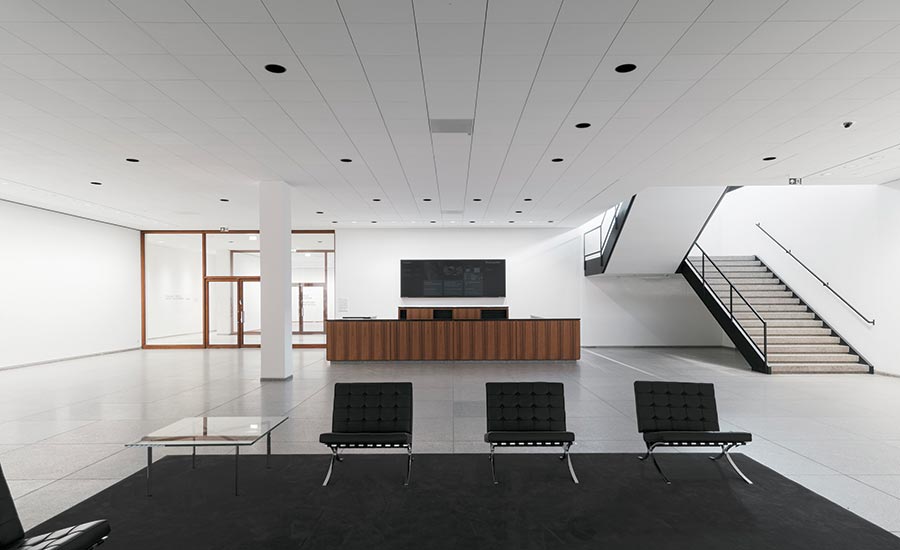
4
On the lower level is a lobby (4) and the cloakroom (5). Photos © Simon Menges
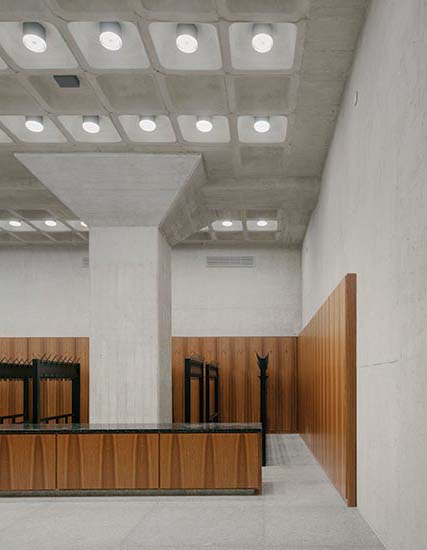
5
In another gesture to counteract the ubiquity of the white walls, the museum commissioned artist Jorge Pardo to create a site-specific installation for the small windowless café. Featuring densely patterned orange-tone laser-cut MDF wall tiles and stepped aluminum luminaires, the café, both an autonomous artwork and place for daily activity, is meant to evoke the approach of Lilly Reich, Mies’s collaborator and exhibition designer.
At the rear garden, where tree roots had badly dislodged the granite paving, new planting, along with benches and a fountain, create loosely defined zones to display 20 sculptures.
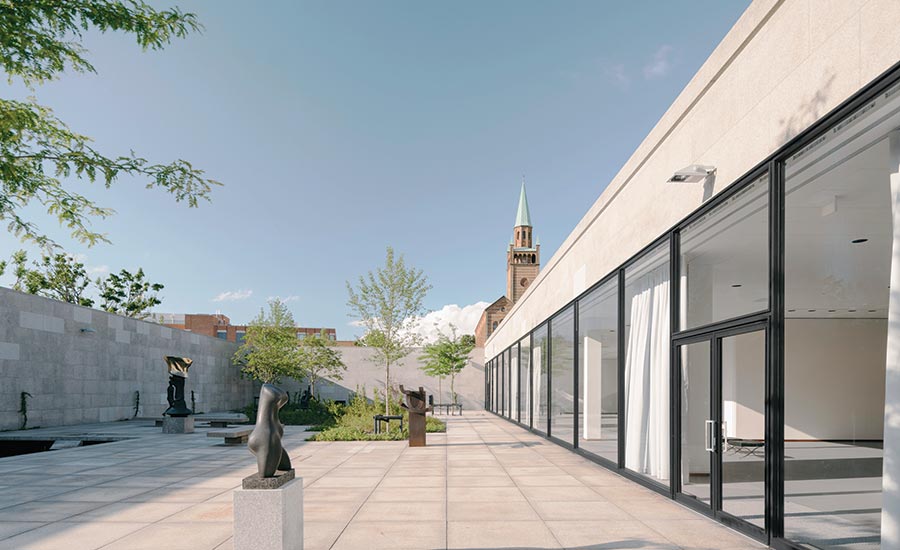
6
Also on the lower level is a sculpture garden (6), and a café by Jorge Pardo (7). Photos © Simon Menges (6), and David Von Becker (7)
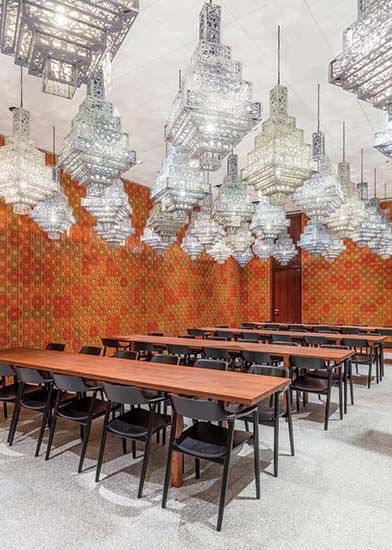
7
For those who experienced the Neue Nationalgalerie prior to 2015, the restored building is a revelation, and a tribute to Mies’s enduring aesthetic. “It survives,” says Chipperfield, “because it is a beautiful building.” As for utility, he adds, “function changes over time.”
Nevertheless, these recent modifications—in addition to the briskly transforming context—do alter the perception of this landmark. No longer a Cold War outpost, it bears witness to Berlin’s turbulent past while holding its own amid a sea of architectural statements. It is well equipped for a new chapter of intense public engagement.
Click drawing to enlarge
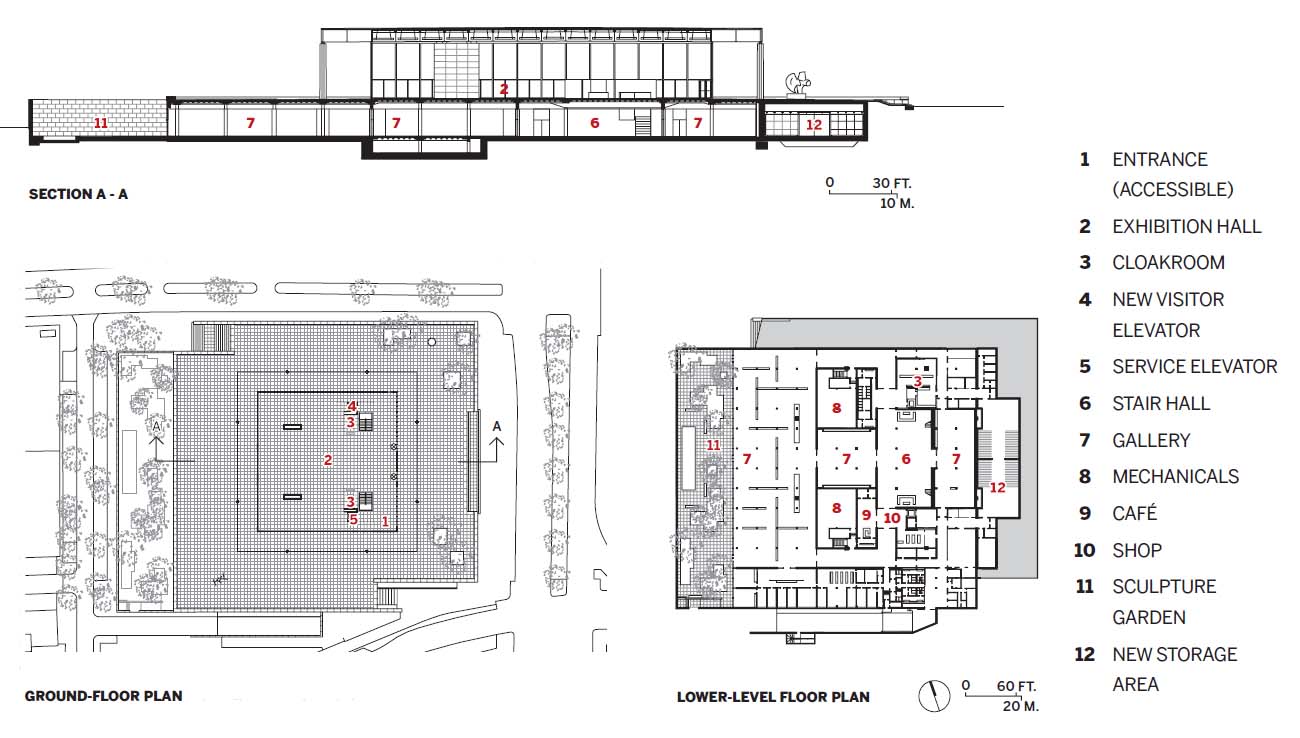
Credits
Architect:
David Chipperfield Architects, Berlin — David Chipperfield, Martin Reichert, Alexander Schwarz, partners; Daniel Wendler, Michael Freytag, project architects; Marianne Akay, Thomas Benk, Matthias Fiegl, Anke Fritzsch,Dirk Gschwind, Anne Hengst, Franziska Michalsky, Maxi Reschke, Sebastian Barrett, Alexander Bellmann, Martina Betzold, Lukas Graf, Martijn Jaspers, Christopher Jonas, Christian Vornholt, Lukas Wichmann, Dalia Liksaite, Simon Wiesmaier, Yannic Calvez, Ute Zscharnt, project team
Executive Architect:
BAL Bauplanungs und Steuerungs
Engineers:
GSE Ingenieurgesellschaft mbh Saar, Enseleit und Partner (structural); Ingenieurgesellschaft W33 mbH with Domann Beratende Ingenieure GmbH (services)
Consultants:
Pro Denkmal (restoration); Muller-BBM (building physics); DS-Plan (facade)
Client:
Stiftung Preussischer Kulturbesitz
Size:
150,000 square feet
Cost:
$165 million
Completion Date:
August 2021
Sources
Glass:
JinJing Group
Tiles:
GOLEM-Kunst und Baukeramik
Sanitary:
Dornbracht
Curtains:
Création Baumann, Langenthal
Carpeting:
Anker Professional Carpet
Modified Historic Luminaires:
Mawa Design



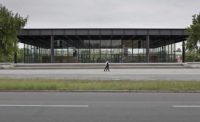
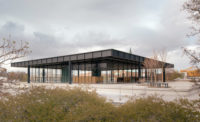
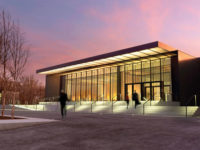
Post a comment to this article
Report Abusive Comment